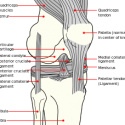 MedicalResearch.com Interview with:
Dr. Grace Hsiao-Wei Lo
MedicalResearch.com Interview with:
Dr. Grace Hsiao-Wei Lo
Baylor College of Medicine
Assistant Professor, Section of Immunology, Allergy and Rheumatology, Department of Medicine, Baylor College of Medicine
Faculty, Immunology, Allergy, and Rheumatology Section,
Michael E. DeBakey VA Medical Center
Medical Research:What is the background for this study? What are the main findings?
Dr. Hsiao-Wei Lo: Controversy exists regarding whether running is harmful versus beneficial to the knee. There is concern that chronic repetitive loading of the knee could physically damage structures within the knee. Alternatively, runners have a lower body mass index, which we know is protective of knee osteoarthritis. Limitations of prior studies evaluating the relationship between running and osteoarthritis include that they have been small studies and they have focused on those participating in a high level or an elite level of running which may not be very generalizable. Addressing the question of whether running is associated with
osteoarthritis is of particular relevance given that recent CDC guidelines recommend that all adults participate in regular physical activity, as there is definitive evidence that increased physical activity is associated with reduced cardiovascular events and mortality.
To address this question, we used data from a multicenter observational study, the Osteoarthritis Initiative (OAI). Of 2,683 participants, 56 percent were female, the mean age was 64.5 and the mean BMI was 28.6. Twenty-nine percent of the participants reported that they ran at some time in their lives.
Patients had knee X-rays, were given symptom assessments, and were asked to complete the Lifetime Physical Activity Questionnaire (LPAQ), identifying the top three most frequently performed physical activities (≥ 10 times in life) they performed at different age ranges throughout their life. Age ranges included 12-18, 19-34, 35-49, and 50 years or older.
Knee X-rays were taken and then scored for evidence of radiographic OA using the Kellgren-Lawrence (KL) grade scale. Participants with KL grades of two or higher were considered as having radiographic OA (ROA). The researchers also measured if participants had frequent knee pain. Researchers considered a participant to have symptomatic OA (SOA) if they had at least one knee with both ROA and frequent knee pain. Anyone with a total knee replacement was classified as having frequent knee pain, ROA and SOA.
After collecting all the data, the researchers reported that runners, regardless of the age when they ran, had a lower prevalence of knee pain, ROA and SOA than non-runners. For people who had run at any time in their lives, 22.8 percent had SOA compared to 29.8 percent of non-runners. People with the lowest BMI scores were the most likely to report being habitual runners. Regular running, even at a non-elite level, not only does not increase the risk of developing knee
osteoarthritis but may protect against it, the researchers concluded.
(more…)













